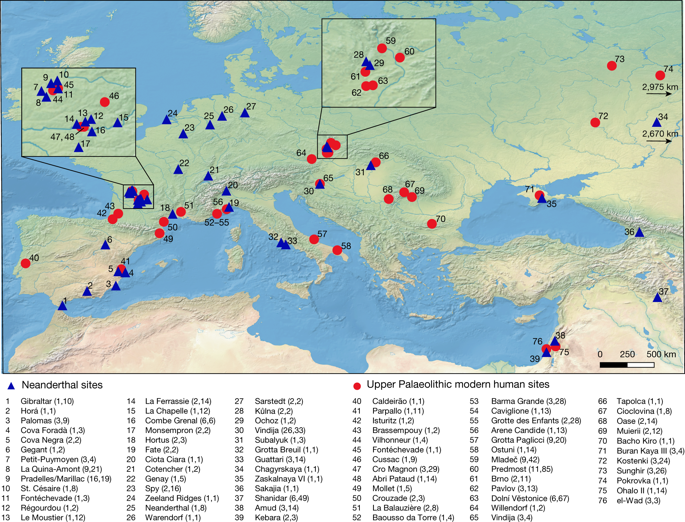Our official English website, www.x-mol.net, welcomes your
feedback! (Note: you will need to create a separate account there.)
Similar cranial trauma prevalence among Neanderthals and Upper Palaeolithic modern humans
Nature ( IF 50.5 ) Pub Date : 2018-11-01 , DOI: 10.1038/s41586-018-0696-8 Judith Beier , Nils Anthes , Joachim Wahl , Katerina Harvati
Nature ( IF 50.5 ) Pub Date : 2018-11-01 , DOI: 10.1038/s41586-018-0696-8 Judith Beier , Nils Anthes , Joachim Wahl , Katerina Harvati

|
Neanderthals are commonly depicted as leading dangerous lives and permanently struggling for survival. This view largely relies on the high incidences of trauma that have been reported1,2 and have variously been attributed to violent social behaviour3,4, highly mobile hunter-gatherer lifestyles2 or attacks by carnivores5. The described Neanderthal pattern of predominantly cranial injuries is further thought to reflect violent encounters with large prey mammals, resulting from the use of close-range hunting weapons1. These interpretations directly shape our understanding of Neanderthal lifestyles, health and hunting abilities, yet mainly rest on descriptive, case-based evidence. Quantitative, population-level studies of traumatic injuries are rare. Here we reassess the hypothesis of higher cranial trauma prevalence among Neanderthals using a population-level approach—accounting for preservation bias and other contextual data—and an exhaustive fossil database. We show that Neanderthals and early Upper Palaeolithic anatomically modern humans exhibit similar overall incidences of cranial trauma, which are higher for males in both taxa, consistent with patterns shown by later populations of modern humans. Beyond these similarities, we observed species-specific, age-related variation in trauma prevalence, suggesting that there were differences in the timing of injuries during life or that there was a differential mortality risk of trauma survivors in the two groups. Finally, our results highlight the importance of preservation bias in studies of trauma prevalence.Neanderthals and Upper Palaeolithic modern humans exhibit similar overall incidences of cranial trauma that are higher for males of both taxa; however, there are species-specific, age-related variations in trauma prevalence.
中文翻译:

尼安德特人和旧石器时代晚期现代人的颅外伤发生率相似
尼安德特人通常被描述为过着危险的生活,并为生存而永久地挣扎。这种观点在很大程度上依赖于已报道的高创伤发生率 1,2,并以不同的方式归因于暴力社会行为 3,4、高度流动的狩猎采集生活方式 2 或食肉动物的袭击 5。所描述的主要颅骨损伤的尼安德特人模式进一步被认为反映了与大型猎物哺乳动物的暴力遭遇,这是由于使用近距离狩猎武器造成的。这些解释直接塑造了我们对尼安德特人生活方式、健康和狩猎能力的理解,但主要依赖于描述性的、基于案例的证据。外伤性损伤的定量、人群水平研究很少见。在这里,我们使用人口水平的方法(考虑到保存偏差和其他背景数据)以及详尽的化石数据库重新评估尼安德特人颅骨创伤患病率较高的假设。我们表明,尼安德特人和旧石器时代早期解剖学上的现代人类表现出相似的颅骨创伤总体发生率,这两种分类群中的男性都较高,这与现代人类后期人群显示的模式一致。除了这些相似之处之外,我们还观察到创伤患病率的物种特异性、年龄相关性差异,这表明两组人在一生中受伤的时间存在差异,或者创伤幸存者的死亡风险存在差异。最后,我们的结果强调了保存偏倚在创伤患病率研究中的重要性。尼安德特人和旧石器时代晚期现代人表现出相似的颅外伤总体发生率,这两种分类群的男性都较高;然而,外伤患病率存在物种特异性、年龄相关的差异。
更新日期:2018-11-01
中文翻译:

尼安德特人和旧石器时代晚期现代人的颅外伤发生率相似
尼安德特人通常被描述为过着危险的生活,并为生存而永久地挣扎。这种观点在很大程度上依赖于已报道的高创伤发生率 1,2,并以不同的方式归因于暴力社会行为 3,4、高度流动的狩猎采集生活方式 2 或食肉动物的袭击 5。所描述的主要颅骨损伤的尼安德特人模式进一步被认为反映了与大型猎物哺乳动物的暴力遭遇,这是由于使用近距离狩猎武器造成的。这些解释直接塑造了我们对尼安德特人生活方式、健康和狩猎能力的理解,但主要依赖于描述性的、基于案例的证据。外伤性损伤的定量、人群水平研究很少见。在这里,我们使用人口水平的方法(考虑到保存偏差和其他背景数据)以及详尽的化石数据库重新评估尼安德特人颅骨创伤患病率较高的假设。我们表明,尼安德特人和旧石器时代早期解剖学上的现代人类表现出相似的颅骨创伤总体发生率,这两种分类群中的男性都较高,这与现代人类后期人群显示的模式一致。除了这些相似之处之外,我们还观察到创伤患病率的物种特异性、年龄相关性差异,这表明两组人在一生中受伤的时间存在差异,或者创伤幸存者的死亡风险存在差异。最后,我们的结果强调了保存偏倚在创伤患病率研究中的重要性。尼安德特人和旧石器时代晚期现代人表现出相似的颅外伤总体发生率,这两种分类群的男性都较高;然而,外伤患病率存在物种特异性、年龄相关的差异。











































 京公网安备 11010802027423号
京公网安备 11010802027423号